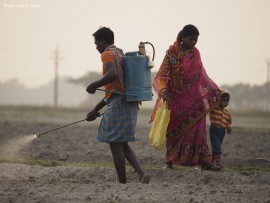Chemical Manufacturing
The U.S. Bureau of Labor Statistics categorizes the following as chemical manufacturing: basic chemicals including pigments, dyes, gases and petrochemicals; synthetic materials like plastics; paint products, cleaning products; and other chemicals including film, ink and explosives. Pharmaceutical manufacturing is also considered under the umbrella of chemical manufacturing. These products and their related chemicals are essential to society and are needed to facilitate our daily life. They treat medical problems, improve standards of living and are relied upon for a vast range of activities. However, during the production of these chemicals and products, dangerous by-products and waste are often generated. A common feature in much of the organic chemical industry is the use of VOCs (Volatile Organic Compounds) as solvents and raw materials, while manufacture of solvents is also a major part of the industry. Dye and pesticide industries are major contributors to the pollution problems of chemical manufacturing. They are addressed separately in this report.
Chemical manufacturing is a large source of pollution worldwide and represents close to 200 of the polluted sites in the Pure Earth’s database, potentially putting approximately 3 million people at risk of exposure. The majority of sites recorded are in China, Eastern Europe and South Asia. The chemical manufacturing industry is truly a global industry with 16 different countries contributing to the trading and selling of chemicals, and there are contaminated chemical manufacturing sites all over the world1.
Part of the reason for the expansive reach of chemical manufacturing is the diverse and varied types of sectors and activities that are included in it. New chemicals are introduced and old chemicals are withdrawn constantly, changing the chemical manufacturing market frequently, making it difficult to monitor and evaluate. The sheer size of the industry makes it difficult to monitor as well; it accounts for approximately 7 percent of global income and 9 percent of international trade2.
Chemical manufacturing contributes an estimated 300,000 to 750,000 DALYs. A key limitation of our approach was our inability to calculate DALYs from VOCs and pesticides. Insufficient dose-response and disability weight information resulted in the complete exclusion of VOCs and pesticides from the calculations at present. The estimate is therefore a considerable under-calculation as it only takes into account the health impacts of lead and chromium.
Associated Pollutants
The pollutants found in the largest quantities at chemical manufacturing sites investigated by Pure Earth include pesticides and volatile organic compounds. However, other pollutants found include arsenic, cadmium, cyanide, mercury, chromium and lead.
It is important to note that although DALY calculations could not be made for volatile organic compounds, exposure to VOCs released from chemical manufacturing sites potentially puts more than 1.5 million people at risk at the sites investigated by Pure Earth. VOCs are low molecular weight chemicals which convert to vapor easily, and VOC vapors are emitted from many products and processes. While many VOCs are relatively non-hazardous (aside from their flammability), thousands of VOCs are toxic, including benzene, formaldehyde, toluene, vinyl chloride and chloroform.
Exposure Pathways
Chemicals can be released through emissions from heating and processing, accidental release of dust or other particulates, accidental spills and improper disposal of solid waste and wastewater. Once in the environment exposure media include air, water, soil and food. In the TSIP database, which focuses on chemical dumps and abandoned sites, the exposure pathways are evenly split between inhalation of contaminated dust and soil, ingestion of contaminated water and food and inhalation of contaminated gases or vapor. The chemical manufacturing industry is the largest single consumer of water by sector in all OECD countries3. The large amount of process water used also provides many opportunities for pollutants to be released through wastewater.
2. Buccini, J. “The Global Pursuit of the Sound Management of Chemicals.” The World Bank Group. Washington, DC. 2004. Available at: http://siteresources.worldbank.org/INTPOPS/Publications/20486416/...
3. Ibid.




